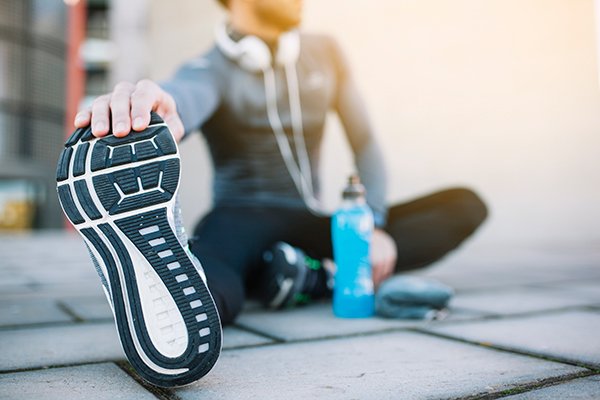Many of us started the new year with a genuine resolve to dedicate more time to physical fitness. Now that we're several weeks into 2021, your lower limbs might be feeling the impacts of increased exercise. We want to help you continue moving forward toward your goals by providing you with the knowledge and resources to care for your feet the way they deserve!

An essential way to ensure that that you achieve your fitness goals is to understand potential injury risks and take preventative steps to avoid them. One of the most common athletic pains is Achilles tendinitis. Below, we have detailed important information about this injury and how to keep it from becoming your Achilles’ Heel!
Achilles tendinitis(opens in a new tab) occurs when the Achilles tendon experiences an abnormal amount of stretching or pressure. This stress can lead to microscopic tears in the tendon, causing pain, swelling, and difficulty walking.
Any active person can fall victim to Achilles tendinitis, but athletes who must frequently jump or engage in activities that involve lateral motion are more prone to suffer (as those types of exercises can add excessive force to the tendon).
Fortunately, there are actions you can take to help prevent Achilles tendinitis. Here are a few ways you can avoid this pain as you exercise more:

Replace your shoes every 400 miles.
Over time, just like any other piece of clothing or equipment, your shoes will wear down. Exercising in deteriorated shoes is particularly dangerous because your feet do not receive adequate support, leaving you more vulnerable to injuries.
We recommend that you replace your shoes every 400 miles they’re used. The following signals will help you identify when it's time to purchase a new sneaker.
- Worn out treads/soles
- Inadequate shock absorption - If you feel the impact of your steps or jumps, that means the shock absorption has worn down!
- Foot pain while exercising
If you need help choosing proper exercise footwear, check out our recent blog where we detail important information to consider.

Always stretch before beginning any strenuous activity.
A proper warmup is as important as the main workout. By stretching before any strenuous activity, you loosen your muscles and better prepare them for the workout ahead. Stretching beforehand not only reduces the chance of injury, it also gives you more flexibility. Be sure to stretch and cool down afterward so that your muscles don’t tighten.

Gradually increase the difficulty of any new exercise.
Although we all want to be pros right off the bat, achieving goals takes time. It’s important to gradually work your body up to the level you want to be at rather than diving right in. For example, if your goal is to run a half marathon, create a training plan that steadily leads up to 13.1 miles. By gradually increasing, you allow your calf muscles to adjust and become more flexible reducing the risk of an injury, like Achilles tendinitis. Too much too soon will only hurt you in the end—pace yourself!
As you tackle those new year’s resolutions, we want to equip you with the knowledge needed to carry them throughout the whole year. The last thing you want is a torn tendon a few weeks into your new goal!
Remember, foot pain is never normal! If you are finding yourself in pain after exercising, don’t wait to get help. Our experienced staff of doctors and physical therapists is ready to treat the problem and get you back on track toward achieving your goals. To schedule an appointment, call (717) 757-3537 or visit our contact page.
